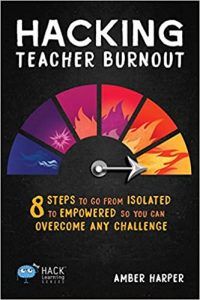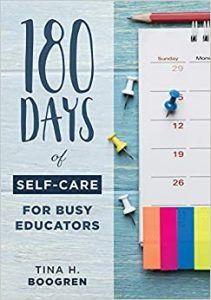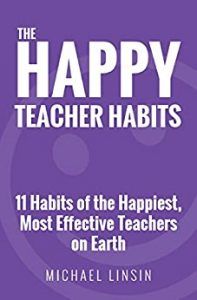Teacher Burnout: 4 Warning Signs & How to Prevent It
 High-stakes assessments.
High-stakes assessments.
Unruly students.
Difficult parents.
Last-minute principal walkthroughs.
A lack of resources or time.
A global pandemic.
These alone are enough to make anyone leave any profession without batting an eye.
Many teachers prepare their entire life for the role, often “playing school” as youngsters and dreaming of becoming a teacher. It takes approximately four to six years of formal education or training to become a teacher. Teachers are also supposed to have weekends, holidays, and summers off. So why would so many teachers choose to leave their profession?
Is teacher burnout to blame?
Read on to learn more about spotting, identifying the root cause, and finding solutions for teacher burnout, as well as how to reignite a passion for the classroom and students.
Before you continue, we thought you might like to download our three Stress & Burnout Prevention Exercises (PDF) for free. These science-based exercises will equip you and your clients with tools to manage stress better and find a healthier balance in your life.
This Article Contains:
- What Is Teacher Burnout? 4 Symptoms
- 7 Possible Causes of Teacher Burnout
- 6 Interesting Research Findings
- How to Prevent Teacher Burnout: 7 Tips
- Assessing Burnout: Scales & Questionnaires
- 7 Solutions to Overcome Teacher Burnout
- 5 Helpful Books on the Topic
- Resources From PositivePsychology.com
- A Take-Home Message
- References
What Is Teacher Burnout? 4 Symptoms
For many educators, teacher burnout can feel like the Sunday blues, the Sunday night anxiety and dread preceding the upcoming work week, day after day.
Teaching is one of the most stressful professions (Kyriacou, 2001; Madigan & Kim, 2021; Saloviita & Pakarinen, 2021). Here are some commonly experienced symptoms that indicate when stress has turned to burnout.
1. Exhaustion
Teachers experiencing burnout may feel exhausted even after hours of sleep because they are doing so much during the day. Alternatively, they may have trouble sleeping, as burnout may manifest in sleep disturbances (Saleh & Shapiro, 2008; Shin, Noh, Jang, Park & Lee, 2013; Pyhältö, Pietarinen, Haverinen, Tikkanen, & Soini, 2021).
2. Depression
Teachers experiencing burnout may also experience symptoms of depression and despair (Saleh & Shapiro, 2008; Shin et al., 2013; Pyhältö et al., 2021).
A loss of interest, feelings of hopelessness, anxiety, irritability, and other symptoms of ill mental health may also be present (Capone, Joshanloo, & Park, 2019; Madigan & Kim, 2021). When teachers are experiencing burnout, they may feel like they are in survival mode each day or react with a short temper.
3. Withdrawal
Teachers experiencing burnout may refrain from attending social or family functions (Schnaider-Levi et al., 2020). They may also avoid collaborating or sharing with other teachers. With withdrawal comes depersonalization, which is a feeling of alienation or a negative attitude toward your surroundings.
4. Physical symptoms
Symptoms of stress may include a racing heart, being unable to catch your breath, and frequent headaches or stomachaches. These indicators are worth keeping a close eye on, as adulthood stress can be a trigger of disease (Kivimäki & Steptoe, 2018).
Teacher burnout rate
In the United States, 44% of new teachers leave the profession within five years of entry (Ingersoll, Merrill, Stuckey, & Collins, 2018).
The United States experiences an 8% teacher attrition rate, while Finland, Singapore, and Ontario, Canada, experience a 3%–4% attrition rate (Sutcher, Darling-Hammond, & Carver-Thomas, 2016).
Of the teachers who voluntarily leave the profession, most credit some type of dissatisfaction, particularly with administrator support (Sutcher et al., 2016). Many refer to this dilemma as a leaky bucket.
7 Possible Causes of Teacher Burnout

Also, working with children should be fun.
Although there are many possible causes of teacher burnout, here are a few of the most common culprits.
1. Lack of time
Teachers often don’t have enough time to complete school obligations, struggle with work–life balance, or have difficulty with time management. In teaching, time is precious and often hard to find. Effective time management can decrease teacher stress and improve job satisfaction (Zafarullah & Pertti, 2017).
2. Lack of resources
Teachers may lack adequate resources (Kyriacou & Chien, 2004) or be inundated with too many resources and curriculum, leading to overwhelm.
3. High demands
Many teachers often take on too much. Whether they want to look good for administration, pad a resume, or genuinely want to make a positive change by getting involved, teachers may sometimes bite off more than they can chew. However, high job demands result in reduced teacher self-efficacy and wellbeing (Skaalvik & Skaalvik, 2018).
Depending on the school, there may be volunteer opportunities to get involved with, including grade-level chairs, committee leads, teacher mentors, and activity heads. Additionally, parents often have instant access to teachers via electronic channels, placing additional stress on teachers.
4. District and state mandates
Testing, an overabundance of assessments, and an obligation to use the curriculum purchased with fidelity could contribute to burnout, as well as students’ performances on these assessments.
Vande Corput (2012) found that these government mandates have had a negative impact on teachers, their preferred styles of teaching, what curricula are emphasized, and how the curricula are taught.
5. Being overworked
Plain and simple, teachers are overworked. Educators wear many hats and perform countless duties, including counselor, psychologist, mediator, social worker, instructor, parent, and nurse. Often, “other duties” are not listed in the job description for teachers (Scriven, 1994).
Teachers may not feel that they are qualified to perform these duties. Nonetheless, they try their best because some of these services are not available to students.
6. Compassion fatigue
Compassion fatigue, also known as secondary trauma, is when teachers feel exhausted, dreadful, sad, overwhelmed, anxious, depressed, or helpless when providing emotional support to their students (Cordaro, 2020). Frequently, teachers are the sounding board for students’ traumatic experiences, and this can take a toll on educators.
7. COVID-19
With the pandemic came mask mandates, social distancing, and hybrid and virtual instruction (Pressley, 2021). These were not the norm prior to the COVID-19 outbreak; teachers had to adapt quickly, sometimes overnight, leading to even more stress.
What is teacher burnout? – Niroga Institute
6 Interesting Research Findings
Burnout was originally formulated to describe the gradual exhaustion and loss of commitment experienced by caregivers in the 1970s in response to chronic work stress (Madigan & Kim, 2021).
With 40%–50% of new teachers leaving the profession within the first five years, it comes as no surprise that teacher burnout plays a major part in the teacher shortage in the United States (Ingersoll & Smith, 2003).
Teacher shortages incur monetary costs for schools and produce negative effects for students, other teachers, and the public education system at large (Garcia & Weiss, 2020).
Increased absenteeism, lower job commitment, and increased turnover directly result from burnout. Burnout is indicative of how likely a teacher is to stay at their job (Billingsley & Bettini, 2019; Brouwers & Tomic, 2000).
Teachers who are burned out also provide a lower quality of instruction than their counterparts (Klusmann, Kunter, Trautwein, Ludtke, & Baumert, 2008; Pyhältö et al., 2021).
As teacher burnout has the potential to inhibit student achievement and motivation, it is critical to prevent and reduce teacher burnout in order to provide students with “quality educational instruction and support” (Madigan & Kim, 2021, p. 11).
How to Prevent Teacher Burnout: 7 Tips
- Set boundaries and create a schedule. Plan to only stay late once per week or only work one day on the weekend if you absolutely have to. Do not have your email linked to your phone. Set a time to unplug completely.
- Learn to turn down extra responsibilities if you already have a full plate.
- Practice self-care. While regular spa treatments, massages, bubble baths, and glasses of wine alone may not prevent burnout, the right combination of eating right, getting enough sleep, exercising, and making time for yourself are good steps to reduce stress levels. Learn and regularly practice stress management techniques such as meditation, mindfulness, and yoga (Madigan & Kim, 2021).
- Cognitive-Behavioral Therapy may be a consideration if you want to change negative thought patterns (Madigan & Kim, 2021).
- From the school’s perspective, the administration can increase teachers’ salaries and provide more administrative support of adequate classroom supplies and mentoring programs for new teachers (Ingersoll & Smith, 2003). New teachers can inquire about the district’s mentoring program. Administrators should also direct positive feedback and praise to their teachers.
- Take a few minutes each day to journal and reflect, listing positive events and things you are grateful for. Recall why you became a teacher in the first place (Hoffman, 2018). Do not compare yourself to other teachers.
- Return to your sense of purpose by reviewing your mission statement and teaching philosophy. If you do not have one, consider writing one. Creating a teacher mission statement or philosophy may help you recall why you chose the profession or, at the very least, serve as an artifact to include in your teaching portfolio when you choose to pursue a different position or school district.
Assessing Burnout: Scales & Questionnaires
The Maslach Burnout Inventory is specifically designed for educators, administrators, other staff members, and volunteers working in an educational setting. The educators’ survey examines emotional exhaustion, depersonalization, and personal accomplishment.
What’s Your Teacher Burnout Type? is a free quiz available at Burned-In Teacher. The creator, Amber Harper, also has an excellent podcast called the Burned-In Teacher Podcast.
MindTools has a short Burnout Self-Test that can help teachers understand the way they feel about their current teaching job and determine if they are at risk of burnout.
OneLegacy offers a Burnout Questionnaire that was part of one of their symposiums. A high score suggests the teacher should recognize their own needs and give themselves some grace.
Teachers should also evaluate their professional and personal support system, know and honor their limits, and learn how to ask for help.
7 Solutions to Overcome Teacher Burnout

The absolute first step is to acknowledge burnout. Determining its possible causes can help start the journey to recovery.
1. Time
Teachers can increase their classroom efficiency by assigning classroom jobs, employing peer grading, giving shorter assessments (determining if a student understands a concept with only a few questions), and using pre-made lessons such as those on TeachersPayTeachers.com, which also includes a plethora of free material.
Understand that not everything needs to be graded or corrected. Sometimes it is beneficial for students to merely practice the skill.
2. Resources
Teachers can also consider soliciting the help of DonorsChoose.org to gain more resources and connect with other professionals to see which resources they consider high priority.
Networking with other teachers through social media groups and hashtags can be a great way to connect with likeminded professionals while avoiding toxic positivity.
3. Demands
Getting immersed in too many activities can leave little time for self-care. Teachers can think twice before volunteering for one more responsibility or even give up a responsibility or two to prevent burnout.
4. District and state mandates
As the saying goes, the only way to eat an elephant is one bite at a time. To navigate district and state mandates, teachers can check in with peers to see how they are managing the directives.
5. Overworked
When possible, it can be helpful for teachers to learn to say no. The Burned-In Teacher course can help teachers connect with other educators who are feeling the same way.
The course also offers resources to support teachers on their journey, additional lesson plans, and the opportunity to participate in live online group coaching calls.
6. Compassion fatigue
To help fight off compassion fatigue, teachers can be sure to take time for themselves, finding hobbies and other enjoyable activities.
For example, if you enjoy reading, try choosing a novel rather than professional literature. Self-care is important. Don’t hesitate to reach out to a professional. Secondary trauma can be hazardous to your health.
7. COVID-19
While teachers cannot control district mandates, they can acknowledge that it was an extraordinarily difficult time period to be teaching in, giving themselves and others the grace they deserve.
5 Helpful Books on the Topic
Taking the time to read a good book can also be a welcoming breather from the demands of teaching. Consider any one of these books to take some well-deserved me-time.
Hacking Teacher Burnout – Amber Harper

Through the strategies, which are driven by the type of burnout, Harper nonjudgmentally leads the reader through burnout so they may not only survive, but also thrive.
Find the book on Amazon.
180 Days of Self-Care for Busy Educators – Tina Boogren

This book offers 36 weeks of themed self-care strategies teachers can use to enhance their lives in and out of the classroom.
Readers will also learn how to assess what the body and mind need and which low-cost solutions are right for them.
Find the book on Amazon.
See Me After Class: Advice for Teachers by Teachers – Roxanna Elden

The tips and strategies for facing challenges head-on are practical, funny, and honest.
Find the book on Amazon.
The Happy Teacher Habits: 11 Habits of the Happiest, Most Effective Teachers on Earth – Michael Linsin

Reviewers described this book as a quick read that will help teachers flourish.
Find the book on Amazon.
The Burnout Cure: Learning to Love Teaching Again – Chase Mielke

Equipped with a combination of positive psychology and social-emotional learning, Mielke light-heartedly shares ways we can shift our awareness, attitudes, and actions to get in the best frame of mind for students and help regain the passion for the profession.
Find the book on Amazon.
Resources From PositivePsychology.com
To learn more about burnout in general, What Is Burnout? 16 Signs and Symptoms of Excessive Stress would be a great place to begin. The Self-Talk Exercise and Coping – Stressors and Resources may help pinpoint the root of stress and identify resources to address it.
Warning Signs of Burnout: 13 Reliable Tests & Questionnaires is an excellent resource where readers can learn more about the Maslach Burnout Inventory and the Oldenburg Burnout Inventory, as well as other helpful tests, quizzes, assessment tools, inventories, and checklists concerning burnout.
How to Prevent Burnout in the Workplace: 20 Strategies present a plethora of ideas to incorporate into a burnout-free plan. You may also want to make use of the Self-Care Checkup, Self-Love Sentence Stems, and the Self-Love Journal worksheets to help encourage progress.
Additionally, the 17 Stress & Burnout Prevention Exercises can help prevent stress from building up and combat existing stress. The Eye of the Hurricane Meditation, Solution-Focused Guided Imagery, Windows of Tolerance, and the Coping Strategy Wheels are just a few of the science-backed and research-based strategies you will learn about in this resource, which is also available in the Positive Psychology Toolkit.
A Take-Home Message
It’s okay if you’re not the teacher with the best-looking classroom or cutest activities.
Relationships are more important than the charming decorations teachers spend so much time making. As Rita Pierson, a teacher for 40 years, so strongly attested in a TED Talk: “Kids don’t learn from people they don’t like” (Pierson, 2013, 1:48). Why then would students enjoy and learn from a burned-out teacher?
Therefore, it is essential that teachers take care of themselves first, whether that involves self-care or a shift in balance. It is critical to understand that burnout may require a combination of the solutions mentioned here. Additionally, what may work for one educator may not necessarily work for all.
Our emotions can serve as a gauge. Listen to what each emotion is telling you, find out why you are feeling each emotion, and determine a way to address each emotion.
If you’re a teacher experiencing burnout, please know that you are not alone. Many teachers experience burnout, from beginners to veterans.
Teaching should be collaborative. Creating units and lesson plans is collaborative, so why wouldn’t addressing stress also be collaborative? If you feel you can’t reach out to a trusted colleague, perhaps seek the help of a professional, such as a counselor or therapist.
No matter your level of expertise, experience, or seniority, we can all be susceptible to burnout. While you cannot control district officials or your administration, you can take control of your own wellbeing.
We hope this article has provided you with the knowledge to identify potential burnout and address this nasty condition. We also hope these strategies help you or your client get out of a rut, fall in love with teaching again, and be there for students.
If you enjoyed reading this article, don’t forget to download our three Stress & Burnout Prevention Exercises (PDF) for free.
- Billingsley, B., & Bettini, E. (2019). Special education teacher attrition and retention: A review of the literature. Review of Educational Research, 89, 697–744
- Boogren, T. H. (2019). 180 Day of self-care for busy educators. Solution Tree Press.
- Brouwers, A., & Tomic, W. (2000). A longitudinal study of teacher burnout and perceived self-efficacy in classroom management. Teaching and Teacher Education, 16, 239–253.
- Capone, V., Joshanloo, M., & Park, M. S. A. (2019). Burnout, depression, efficacy beliefs, and work-related variables among school teachers. International Journal of Educational Research, 95, 97–108.
- Cordaro, M. (2020). Pouring from an empty cup: The case for compassion fatigue in higher education. Building Healthy Academic Communities Journal, 4(2), 17–28.
- Elden, R. (2013). See me after class: Advice for teachers by teachers (2nd ed.). Sourcebooks.
- García, E., & Weiss, E. (2020, October 15). Examining the factors that play a role in the teacher shortage crisis: Key findings from EPI’s ‘Perfect Storm in the Teacher Labor Market’ series. Economic Policy Institute. Retrieved from https://www.epi.org/publication/key-findings-from-the-perfect-storm-in-the-teacher-labor-market-series/
- Harper, A. (2020). Hacking teacher burnout: 8 Steps to go from isolated to empowered so you can overcome any challenge. Times 10.
- Hoffman, M. (Host) (2018, January 15). Teacher burnout [Audio podcast episode]. In I’ll Wait. https://podcasts.apple.com/us/podcast/teacher-burnout/id1269514379?i=1000399858616
- Ingersoll, M., Merrill, E., Stuckey, D., & Collins, G. (2018). Seven trends: The transformation of the teaching force – Updated October 2018. CPRE Research Reports, 108. Retrieved from https://repository.upenn.edu/cpre_researchreports/108
- Ingersoll, R. M., & Smith, T. M. (2003). The wrong solution to the teacher shortage. Educational leadership, 60(8), 30–33.
- Kivimäki, M., & Steptoe, A. (2018). Effects of stress on the development and progression of cardiovascular disease. Nature Reviews Cardiology, 15(4), 215–229.
- Klusmann, U., Kunter, M., Trautwein, U., Ludtke, O., & Baumert, J. (2008). Engagement and emotional exhaustion in teachers: does school context make a difference? Health and Wellbeing, 57, 127–151.
- Kyriacou, C. (2001). Teacher stress: Directions for future research. Educational Review, 53(1), 27–35.
- Kyriacou, C., & Chien, P. Y. (2004). Teacher stress in Taiwanese primary schools. The Journal of Educational Enquiry, 5(2).
- Linsin, M. (2016). The happy teacher habits: 11 Habits of the happiest, most effective teachers on Earth. JME.
- Madigan, D. J., & Kim, L. E. (2021). Does teacher burnout affect students? A systematic review of its association with academic achievement and student-reported outcomes. International Journal of Educational Research, 105, 101714.
- Mielke, C. (2019). The burnout cure: Learning to love teaching again. ASCD.
- Pierson, R. (2013, May). Every kid needs a champion. TED [Video]. Retrieved September 29, 2021, from https://www.ted.com/talks/rita_pierson_every_kid_needs_a_champion?language=en#t-100042
- Pressley, T. (2021). Factors contributing to teacher burnout during COVID-19. Educational Researcher, 50(5), 325–327.
- Pyhältö, K., Pietarinen, J., Haverinen, K., Tikkanen, L., & Soini, T. (2021). Teacher burnout profiles and proactive strategies. European Journal of Psychology of Education, 36(1), 219–242.
- Saleh, P., & Shapiro, C. M. (2008). Disturbed sleep and burnout: implications for long-term health. Journal of Psychosomatic Research, 65(1), 1–3.
- Saloviita, T., & Pakarinen, E. (2021). Teacher burnout explained: Teacher-, student-, and organisation-level variables. Teaching and Teacher Education, 97(5), 103221.
- Schnaider-Levi, L., Ganz, A. B., Zafrani, K., Goldman, Z., Mitnik, I., Rolnik, B., & Lev-Ari, S. (2020). The effect of inquiry-based stress reduction on teacher burnout: A controlled trial. Brain Sciences, 10(7), 468.
- Scriven, M. (1994). Duties of the teacher. Journal of Personnel Evaluation in Education, 8(2), 151–184.
- Shin, H., Noh, H., Jang, Y., Park, Y. M., & Lee, S. M. (2013). A longitudinal examination of the relationship between teacher burnout and depression. Journal of Employment Counseling, 50, 124–137.
- Skaalvik, E. M., & Skaalvik, S. (2018). Job demands and job resources as predictors of teacher motivation and well-being. Social Psychology of Education, 21(5), 1251–1275.
- Sutcher, L., Darling-Hammond, L., & Carver-Thomas, D. (2016, September 15). A coming crisis in teaching? Teacher Supply, Demand, and Shortages in the U.S. Learning Policy Institute. Retrieved from https://learningpolicyinstitute.org/product/coming-crisis-teaching
- Vande Corput, A. R. (2012). Teaching to the test: How federal mandates affect elementary educators’ teaching styles. The Kennesaw Journal of Undergraduate Research, 2(1), 4.
- Zafarullah, S., & Pertti, V. (2017). Effect of time management on the job satisfaction and motivation of teacher educators: A narrative analysis. International Journal of Higher Education, 6(2), 213–224.
Let us know your thoughts
Read other articles by their category
- Body & Brain (42)
- Coaching & Application (54)
- Compassion (26)
- Counseling (50)
- Emotional Intelligence (24)
- Gratitude (18)
- Grief & Bereavement (21)
- Happiness & SWB (40)
- Meaning & Values (25)
- Meditation (20)
- Mindfulness (44)
- Motivation & Goals (43)
- Optimism & Mindset (32)
- Positive CBT (25)
- Positive Communication (20)
- Positive Education (45)
- Positive Emotions (30)
- Positive Leadership (14)
- Positive Psychology (32)
- Positive Workplace (33)
- Productivity (16)
- Relationships (41)
- Resilience & Coping (34)
- Self Awareness (20)
- Self Esteem (36)
- Software & Apps (13)
- Strengths & Virtues (30)
- Stress & Burnout Prevention (34)
- Theory & Books (44)
- Therapy Exercises (35)
- Types of Therapy (58)





What our readers think
I agree with the different ways that you may become burnt out. I have experienced some of these issues myself. What I am finding out is that I need to take more time out for myself. Give myself some selflove and care. Remind myself to take time out for myself because I always put work first. Thank you for the different ideas.